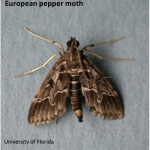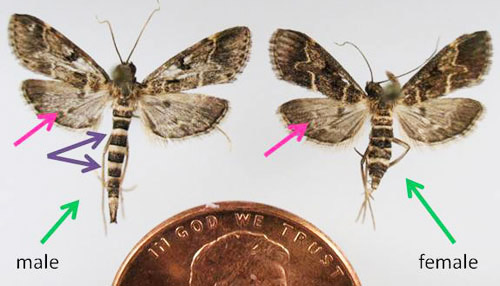 A south Jersey nursery/greenhouse operation has a probable infestation of European pepper moth, Duponchelia fovealis, family Crambidae. This group of moths includes European corn borer and garden webworms. Both adults and larvae have been found. Adults match literature descriptions and a larva has been identified to this species. Once fresh adults have been caught, specimens will be sent to the Systematic Entomology Laboratory for positive identification, where it will likely be considered a state record.
A south Jersey nursery/greenhouse operation has a probable infestation of European pepper moth, Duponchelia fovealis, family Crambidae. This group of moths includes European corn borer and garden webworms. Both adults and larvae have been found. Adults match literature descriptions and a larva has been identified to this species. Once fresh adults have been caught, specimens will be sent to the Systematic Entomology Laboratory for positive identification, where it will likely be considered a state record.
The female moth lay eggs singly or in small egg masses similar to European corn borer on the underside of leaves and upon hatching the larvae descend into the soil feeding on roots and stems of both woody and herbaceous host plants. Severe damage including plant death may occur from the larvae girdling the stems. The caterpillars produce webbing especially in the area of its feeding. Caterpillars are usually found in the soil mix, between containers and even under plant trays. The plant host range is extensive with many ornamental plants, potted flowers, and vegetable bedding plants being susceptible. EPM is primarily a greenhouse pest but field infestations may occur as well. The moth cannot overwinter through harsh conditions so it is unlikely that it will be able to overwinter in New Jersey. However, since 2004 EPM has been found in several states and Canada. Dispersal is largely through the transport of infested plant material.
Management of the EPM includes chemical and biological controls and also sanitation. The caterpillars are able to live in plant and soil debris, which hinders chemical control. Although a number of insecticides are available for use against the moth, there may not be a consistent response to the applications and the current infestation has not responded well to the use of insecticides. Several biological control agents are available.
Refer to the following websites for more information on plant hosts, biological control agents and chemical options.
http://entnemdept.ufl.edu/creatures/veg/leps/european_pepper_moth.htm
https://extension.umd.edu/learn/greenhouse-ipm-pest-alert-european-pepper-moth

Adult European pepper moths, Duponchelia fovealis (Zeller), showing three identification features: abdomen has cream-colored rings (purple arrows) encircling it ; males have a longer, slimmer abdomen compared to females (green arrows); and cream-colored wavy lines (pink arrows) across the middle of the hindwings. Photograph by James Hayden, Florida Department of Agriculture and Consumer Services, Division of Plant Industry.

